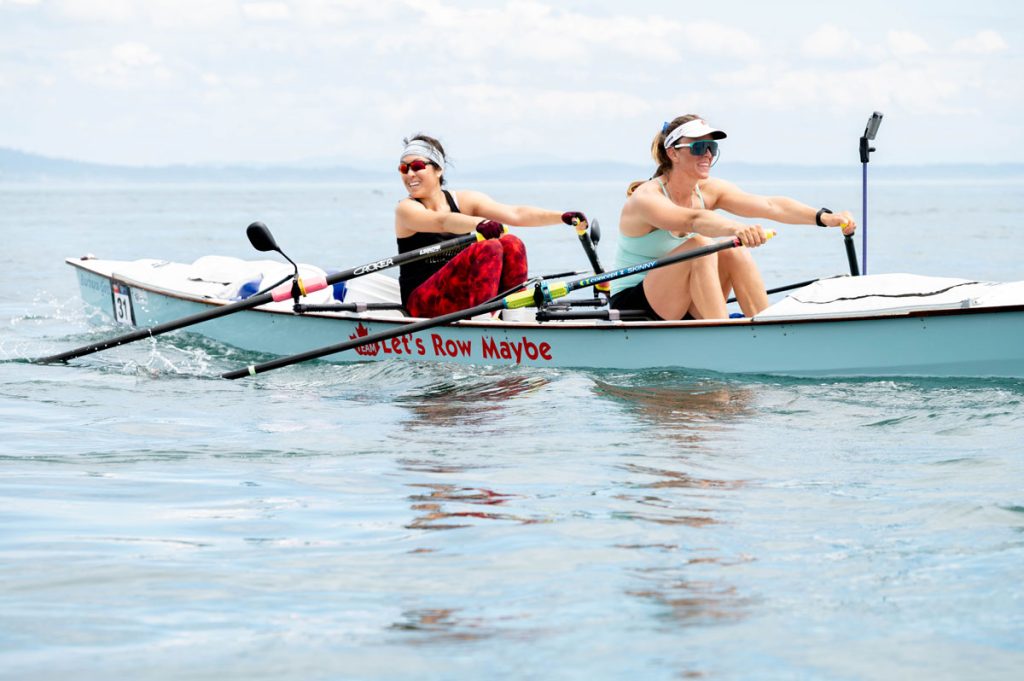Field Report | 24-Hr Fact Sheet
photo: Team Let’s Row Maybe? by Rebecca Ross
While all of us here in R2AK’s Mobile Command will deny it and fight you if you press the point, even as we cringe at what might politely be called “Hippy Shit,” we’ll begrudgingly concede that there are moments in life that possess a certain energy that even to our calloused chakras (or whatever) feels somewhere between important and holy. We have no idea if magic is alive, even less faith that the goddess is afoot, but know first hand that there’s a vibrational significance in the act of casting off (or whatever).
Even if you’ve never raced to Alaska, think of the last time you executed the final act of commitment to something big. Setting off to hike the PCT, getting married, leaving the plane with your parachute, moving out of your parents’ house, getting divorced, the exact moment when the airplane lifts off and you’re on your way to living abroad. Each of these moments of committed departure are the punctuation of a chain of decisions that brought you that far, but the departure is the final and magic act.
In the hours before Stage Two’s Victoria start, the air had the energy that something big was about to happen. Even the casual passerby could feel the carbonated anxious of racers making sure things were set. Checking, double-checking, last-minute errands, last-minute repairs, the lingering, loving, worried, supportive, then final goodbyes for friends, fans, and loved ones. Teams winnowed their tool boxes to save weight, agonizing between the choice of not enough and too much. “I don’t think we’re going to need this,” one racer evaluated as they transferred the whatever it was from the stuff traveling north to the tub going home, then stared at it for two lingering seconds. Would they?
For R2AK veterans, the whole scene felt as familiar as it did foreign. It had been a while, years since they’d done this particular madness. There were versions of surprise preparations everywhere, but there are no more experienced R2AK racers than Ian and Janice on Team Oaracle. Between the two of them, they’ve collectively been in every single R2AK since the beginning. Were they ready? “Last night I was up late packing food.” Three years since the last start and with hours to go, groceries were still going into dry bags. What’s worse? “At 10 pm I found cracks in the hull.” Break out the epoxy and fiberglass, add some hair dryers to help it kick off in time for the race start in 14 hours, pray and sleep.
Chakras don’t lie: the inner harbor’s anxious repair/repack energy started low key at first light, then crescendoed logarithmically until 10 minutes before noon when the docks were cleared and teams made their way to the top of the seawall, along with a crowd of 1,000 or so race fans and bewildered tourists who just wondered what everyone was looking at, and then stayed to witness the action.
A horn sounded and began the five-minute countdown. Teams high-fived, stretched for the sprint, and selfied with wild abandon. The Le Mans start requires teams to run down two flights of seawall steps then down the docks to cast off. If you’re fast you can shave seconds off of a finish time that will eventually be measured in days to weeks. Seconds. It’s as important as it is practical. A minute to go, Race Boss Daniel Evans offered R2AK’s brand of Brene Brown/Tony Robbins, inspiring hippy shit/motivational chakra talk. People cheered, cried, and counted down: 10, 9, 8, 7, 6, 5, 4, 3, 2… and with 1 and go—magic.
The errands were done; the Straits were crossed; skippers’ meetings, lay days, and repairs were in the rearview. The agonizing about could we and should we melted away as racers ran down to the docks and cast off the physical and metaphoric mooring lines. After days and years, time to Race to Alaska.
If you didn’t watch the live feed, rewind and do. The Victoria start is the clumsiest version of hilarious chaotic that the sailing world has ever seen. Boats not meant to do anything other than talk about when and where to Code Zero go pedaling through the provincial capital’s seaplane landing strip while rowboats horizon the sailing fleet’s awkward sweaty progress. This year, most years if we’re being honest, when the fleet reached the point where the actual Queen ordains that it’s legal to hoist their sails, they did so just to learn that it was flat ass calm—for hours, in both directions. Keep pedaling.
Monday’s maelstrom had given way to the nothing of Thursday. From the time teams left the inner harbor to the cats-paw sundown in the Gulf Islands, there was very little to absolutely no wind. Same was true-ish for the west bound fleet, but some of them apparently didn’t need it. At the harbor mouth’s east/west sorting hat, Team Pure & Wild chose west and was doing at least six knots in roughly that much wind. That kind of magic cannot happen without some sort of chicken bone incantation, but it did.
You already know this, but three teams decided to blaze trail by going west of Vancouver Island in the first year the race had it as an option. For Team Pure & Wild, they had decided from the beginning—“We don’t like tacking”—but Kootenay Pedalwheelers decided on their way out, mostly. When they left the harbor they could be seen pouring over charts, and were reportedly 50/50 on what to do. Not sure which of their five crew was the swing state, but outside they went.
The outside teams were stymied by the same incoming tide that flooded the rest of the fleet north up the inside. Things changed around 8 pm, and fortunes were reversed.
Those rowers tho! At least until they needed to sleep, Team Let’s Row Maybe? and Don’t Tell Mom won the day before ending up in the same provincial park on the north side of Prevost Island, and Team Interstice’s solo rower sacked out a few miles south. Impressive stuff for Day One.
As Day Two dawned, R2AK 22 experienced its first deity epithets and Thank Goddesses. Team Pocket Rockanauts capsized in the early morning light around Saturna Island. Smart fellers that they are, everyone was in PFDs and Mustang Survival drysuits and are ok. Their G-32 experienced downflooding in one of the amas so assistance was required to get it back up, and some soul searching will be required to make sure it doesn’t happen again in the course’s remote expanses.
Team Pestou’s impressive solo bid was also cut short early Friday due to some delamination issues in his hull. He was killing it until he ran into a log and his boat started peeling itself apart. At the time of posting, he was limping to Gibsons to sort things out. Sad fans around Tracker Nation are starting to rally a vigil/festival in his honor—”Pesty Festy” is the current working title.
Team Pturbodactyl suffered damage forcing them from the race. Early reports are that there is damage to the diagonal strut that attaches their ama to the rest of the boat. Amas are important to keeping trimarans upright, keeping them attached more so. Prudent move is to pull over. Glad everyone is safe and all hopes that the henge is unharmed.
Not to belabor the fact that all this hippy shit is off brand, but while it most definitely is, for all of us in R2AK’s command bunker it’s getting pretty clear to our crystals that Race to Alaska has become a prism of intention. If you want to win, if you want adventure, closure, a big ocean hoopla, a rite of passage, steak knives, or big life transition—you can find any of those, but the price of admission is that along the way your spectrum will be split into any number of colored truths that are entirely out of your control. While it might not break them, Racing to Alaska is to at least tug at the chains of life’s convenient disappointments. Casting off is where it all starts—how and where you land is up to you and the route you choose.
Friday’s weather is expected to build on both inside and outside alike, and while we have zero idea of how to judge the progress of the western route, for the inside it’s looking possible that Team Malolo could make the Seymour Narrows for the morning’s northbound tidal train. No idea, we’re often wrong, but maybe. Today’s currents look to top out at 12 knots before the watery conveyor belt switches directions and forces everyone to march in place for a few hours before it changes again.
Keep an eye on the weather, set your chakras to rainbow, put on another pot of coffee, do a yoga, and stay tuned. This race is just getting started.

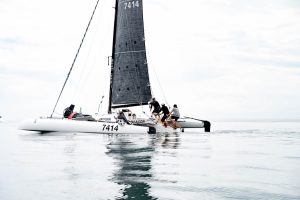
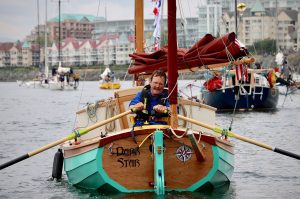
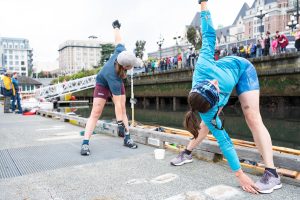
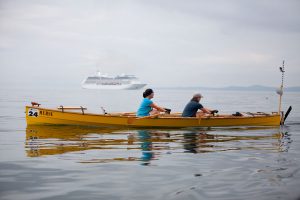
First & last photo by Lynnette Oostmeyer, second & fourth photo by Rebecca Ross, third photo by Zach Carver
24-Hr Fact Sheet
- 430 – Gallons of water pumped from boats while in Victoria
- 100+ – Fasteners used by Team Loustic SuperSonic to reattach the deck of their boat to their hull
- 41 miles – Distance both teams Don’t Tell Mom and Let’s Row Maybe? rowed in Day One
- 41 miles – The most miles Clare of Team Don’t Tell Mom has ever rowed in one go
- 2 – Number of 360s Team Lost But Don’t Care spun in the tidal rapids off Turn Point
- 1 – Pink spinnaker in the race
- 10 – Race SPOT trackers that immediately stopped functioning right after the race start
- 14 – Times we overheard someone describing Mustang Survival’s Team Rite of Passage by exclaiming “Their average age is 16.75 years!”
- 1 – Team that still looked to be in bed at the race start (Fix Oder Nix)
- 3 – Teams deciding to take the west coast route (Pure and Wild, Elsewhere, Kootenay Pedalwheelers)
- 33 – Teams started in Victoria
- .03% – Of all teams decided to sail through Portlier Pass (Malolo)
From the Field: A Silver Lining After a Rough Start
By Rebecca Ross, Field Reporter
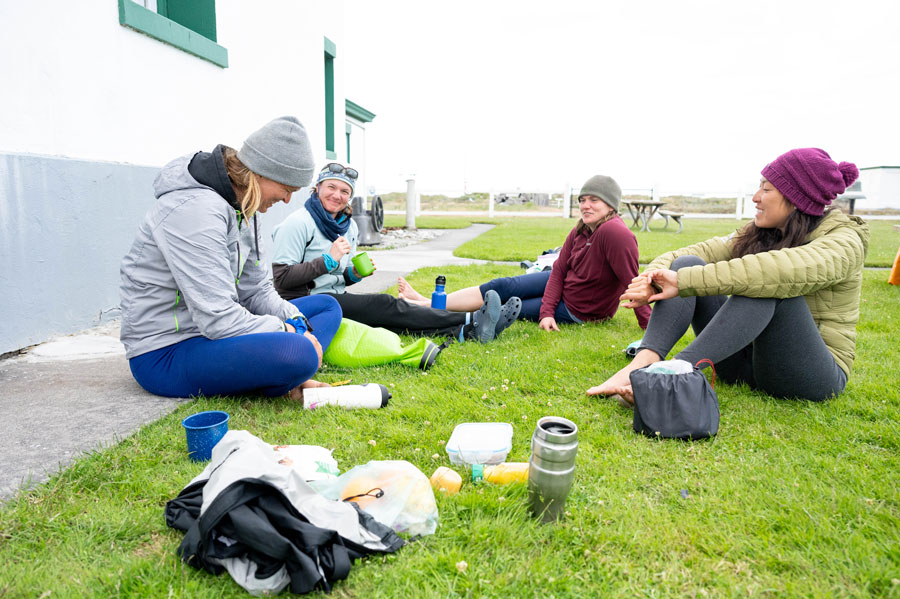
On day two, I hopped on ‘Ripsaw’ the 15’ RHIB and made my way to meet the small row teams stuck on Dungeness Spit—waiting for the foul weather to subside. I imagined the teams hunkered down against the wind, aimlessly shielding sand from tainting their food while sitting on a wet log. They’ve got to be cold and miserable out there.
Shortly after reaching shore, I spotted Clare and Leigh from Team Don’t Tell Mom, smiles plastered on their faces. The two greeted me immediately before leisurely decorating their boat with an R2AK flag. Definitely not the scene I was imagining.
“How did it go out there?” I asked Leigh, her smile going strong.
“The crossing was rugged, it started out pretty well, but then the winds got worse. Three to four-foot waves mostly until they turned into five to six-foot waves. We took lots of waves over the bow, got soaked, and had to bail a lot. It was some of the toughest rowing I’ve done,” she replied… Keep reading.
